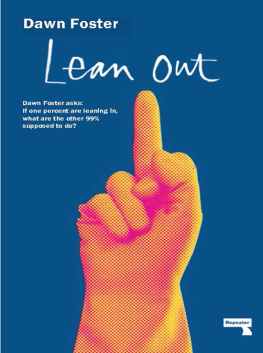Summary and Analysis of
Lean In
Women, Work, and the Will to Lead
Based on the Book by Sheryl Sandberg

Contents
Context
Written by one of the most powerful female leaders today as a response to her experiences coming of age during the 1970s and 80s, Lean In examines how the feminist ideals of Sheryl Sandbergs youth failed to level the playing field. As such, the work is both a criticism of her generations failure to fully embrace the inroads that were made by the women who preceded them, and of the patriarchy that continues to rule the workforce.
Written by the brilliant and successful COO of Facebook, Lean In examines the ways in which women sabotage their own careers and the institutionalized gender bias still pervades American business culture. Lean In was written during the years of third-wave feminism, which began in the 1990s, largely as a backlash against second-wave feminism, the movement of the 1960s and 70s that highlighted issues such as family, work, and sexuality.
Though third-wave feminists, led by Gen Xers such as Sandberg, benefitted from the work of the second-wavers, they emphasized organized feminist groups, the empowerment of young girls, greater division of responsibilities in the household, and a more stringent criticism of racism, elitism, and sexism as obstacles to womens equality. They also sought to question and redefine gender stereotypes, particularly around ideas of beauty and femininity, allowing for more personal and less prescribed expressions of those attributes (for example, being a strong woman does not necessarily mean wearing a mans suit or adopting male characteristics at work).
Having made her way to the highest levels of corporate success, Sheryl Sandberg set out to share her insights and experience to inspire women around the world to literally lean in to their careers and their lives.
Overview
Sheryl Sandberg, the Chief Operating Officer of Facebook and former executive at Google, delivered a TED Talk in 2010 in which she passionately discussed the inequality gap between men and women in leadership positions in government and private corporations, specifically touching on how women inadvertently get in their own way. To counter this, she extolled them to lean in to their careers.
The talk became a sensation, with more than six million page views to date, and inspired Sandberg to write the New York Times bestselling book Lean In: Women, Work, and the Will to Lead , which has been compared to Betty Friedans seminal book The Feminine Mystique , a landmark feminist publication in 1963.
Lean In , which relies heavily on the narrative of Sandbergs own career trajectory, starting from her college days at Harvard, as well as her personal observations as a female business leader, also includes multiple studies and accounts of other high-profile women in leadership roles. The overarching theme is that despite all the strides women have made, particularly by surpassing men in college graduation rates, they still hold a disproportionately low number of top-ranking jobs, and are still paid less than men in equal positions.
Though Sandberg places the blame, in part, on the lack of supportive structures for women in the workplace, Lean In is more of a battle cry for women to critically examine the career choices they make, many of which Sandberg believes are unintentionally self-sabotagingfrom failing to take risks at work, to scaling back their dedication to their jobs in the years leading up to pregnancy; from relying too heavily on what she deems the false magic bullet of mentorship, to not holding their partners accountable for their share of childrearing and domestic responsibilities.
Sandberg describes the current workplace not as a meritocracy where women will simply be rewarded for hard work but, rather, as a high-speed race that demands seizing opportunities and creating prospects where there may not appear to be any. From her own unique perspective as one of the most powerful businesswomen in the world, she describes how she witnesses men taking the initiative to get ahead. They come to her with requests for promotions, to lead projects, and to create new roles for themselves while, conversely, women are generally reluctant to advocate for themselves in the same way.
This is tied to several factors, starting with gender stereotyping that begins as early as childhood, when girls are rewarded for being polite and nice, and boys are expected to be go-getters. Later in life, this translates into women paying a penalty at work when they act outside of that social norm. Likewise, Sandberg believes that because women are expected to be nurturersdespite advances in technology (like breast pumps) that allow men to fully participate in childcarethey are often more likely to give up their careers to raise children.
Though she is careful to reserve judgment on women who choose to stay home, she believes that it is possible to have a fulfilling career and a vibrant family life, and provides tips and strategies for how to make it happen, acknowledging, however, that striving to achieve a perfect work-life balance is not realistic.
Lean In is full of practical advice on how to negotiate as a woman, balance likability with ambition, advance through unconventional ways, and support other women in an effort to create a groundswell of empowerment. All of these actions will ultimately lead to more women at the top and, consequently, create more practices and programs such as better maternity-leave policies and leadership training that force those in executive roles to address and conquer gender bias.
Summary
Introduction: Internalizing the Revolution
Although women in the United States and the developed world are better off than theyve ever been, were still a long way from gender equality. Out of 195 independent countries, only 17 are led by women, and women hold only 22% of parliament seats globally. In the United States, despite the fact that there are more women graduating with college degrees than men, only 23% of S&P 500 companies have female CEOs and women only hold 25% of executive officer positions. For women of color, the gap is even worse. The same fight occurs for compensation. As of 2010, women earn 77 cents for every dollar that men earn.
Sandberg has experienced this inequality firsthand. After spending decades working in large corporations, she noticed that each year, fewer and fewer of her colleagues were women. Often, shes the only woman in the room. She asks, how can women break down the barriers and secure powerful roles?
Many women face sexism and sexual harassment in the workplace. Businesses rarely offer flexibility for childcare or maternity leave, making it difficult to raise a family and have a career. In addition to the external roadblocks, women are hindered by countless internal barriers, too. They often hold themselves back, fearful of being selfish, rude, disruptive, or aggressive, since, from a young age, they are taught to be calm and nurturing, and to play nice with others. If women are able to rid themselves of their internal blockades, they can begin tearing down the external ones.
Sandberg urges her readers to lean into be assertive, not passive, and to be ambitious in every pursuit. In order to achieve equality in the workplace, each woman must take her career into her own hands, then stand with and support other women and reignite the revolution.
1. The Leadership Ambition Gap
Sandberg concedes that while her generation had far more educational opportunities than those before her, and despite ambitious, competitive women graduating from college, the world has not evolved as much as she originally predicted when it comes to equality for men and women in the workforce. In fact, she tells us that women are dropping out of the workforce in high numbers partly because they have learned from their own mothers that it is not really possible to achieve a true work-life balance. This, she suggests, is a systemic issue relating to Americas lack of paid maternity leave and other support systems for mothers in corporate life.












